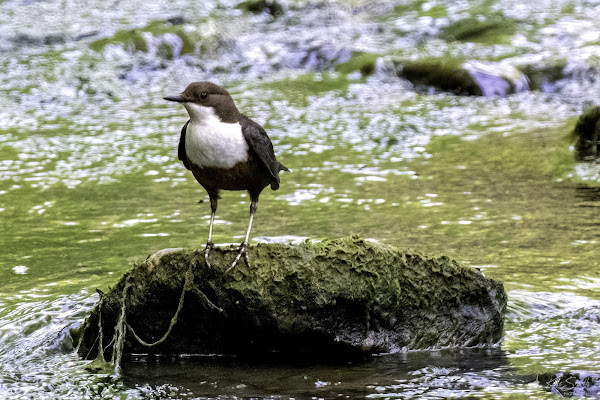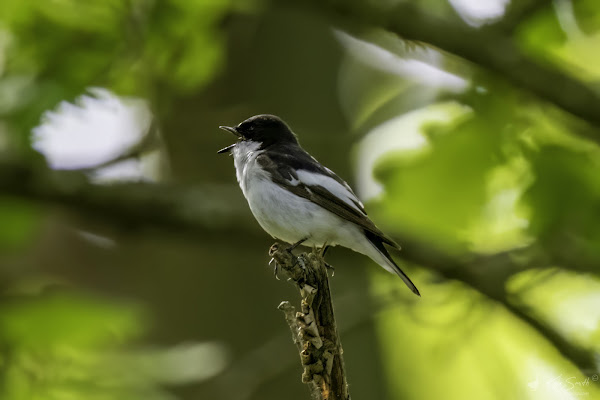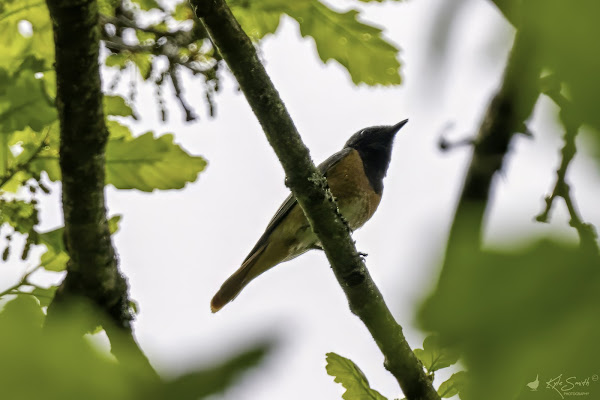We'd been waiting for our annual trip to the Wyre Forest to see the array of woodland dwellers, returned to the UK for the Spring breeding season. We fuelled up on the way and arrived a little later than usual, meeting John Coakley @John1Coakley, Steve Nikols @nikols_steve and Gary Hobbs @NuneatonBirder in the car park. While birding would be part of their day, they were here to see the pearl-bordered fritillary butterflies; a medium-sized butterfly with a wingspan of about 38-46 mm. Between 1982 and 1997 its UK range contracted by over 50%, making it one of the most rapidly declining butterflies in Britain. The upper side of the wings is orange with black spots and markings while the underside of the hindwings features a series of white pearls (hence the name) bordered by black and orange patterns. It can be confused with the small pearl-bordered fritillary, but the latter has a more intricate pattern on the underside of its wings, smaller "pearls" and typically arrives a few weeks later.
It wasn't long, and the three amigos were ahead as we held back waiting to hear or see any of our target species. Our first was a lone tree pipit high in the distant trees, giving it large. The tree pipit is a migratory songbird that breeds in the UK and like many others, winters in sub-Saharan Africa. As you can see in the photo, the tree pipit is a small, slender bird with streaked brown upperparts and a pale, streaked underside. It has a thin bill and a fairly long tail with white outer feathers. It can be confused with the meadow pipit, but it has a stronger face pattern, bolder streaking on the breast, and a more prominent pale spot at the base of the bill. Tree pipit is known for its distinctive song flight where males sing a series of descending notes while flying upwards from a perch, and then parachute down with wings and tail spread. It would be the only one we'd see.
We continued and soon came to a spot where there are two nest boxes that are often favoured by pied flycatchers. Sure enough, a few minutes wait gave us good views of a male working around the trees, mostly from 10ft and up. These are one of my favourite Spring sprites, a delightful and distinctive small bird that visits the UK during its breeding season. Males are striking with black upperparts and white underparts and have a prominent white patch on their forehead and white wing bars. Females are more subdued in colour, with brownish-grey upperparts and paler underparts. They also have white wing bars but lack the prominent white forehead patch - we'd not see a female all day - perhaps all on a nest? They are active foragers, catching insects in flight or picking them from leaves and branches. Their diet mainly consists of flies, beetles, caterpillars, and other small invertebrates.
Try as we might, we couldn't find a wood warbler in the spots we traditionally locate them - talking to the other birders, none of them could find one either. Reports on Twitter suggested that they must be arriving late, but this is getting worrying now - later than we've traditionally seen them.
We worked down to Dowles Brook and turned left to a spot where redstarts nest in an old tree, unfortunately finding that the tree had gone. Damn and a shame. We bumped into another birder who'd been watching dippers and had lost them upstream but was now on a bird that he'd seen in the canopy - it turned out to be a spotted flycatcher, another first for the year. It was tricky to see unless you were in the right position and I just couldn't get it in the camera viewfinder before it departed, stage left.
We continued along the brook hoping for a view of a dipper - I'd had several in Scotland but Kev @kev07713 was still waiting. We reached a bridge that crosses the brook and stopped to look at a spot we suspected is where they nest. It took at least 20 minutes but then a dipper dropped onto a rock in the opposite direction from the spot we were watching. It bobbed a few times and then flew under the bridge and onto the bank opposite the area we'd been scanning. It preened a little then popped into the area we think it nests, and within minutes it was back out and flew almost between us on the bridge. A great experience.
We walked back up the slope, passed the mill, and watched for pied flycatchers, wood warblers, redstarts and tawny owl - reported in this area. We came across some male pied flycatchers, but none of the others - we did find two birders/photographers that had been lucky enough to see badger on the path earlier, and a tawny owl in one of the trees. We stopped to enjoy the flycatchers.
We were still keen to find a wood warbler so pushed on and eventually ended up back on the main track. A goldcrest dropped in a tree right beside us and gave it large, completely happy with us being within 10 feet - a second bird eventually dropped right onto it and they both departed.
We met with Steve, John and Gary to hear that they had been successful with their butterflies. Later we'd see their photos on Twitter: Steve's here & here; John's here. They'd also found a redstart and seen the badger. We decided to separate and go in search of wood warbler and redstart down a path we'd never tried before.
We stopped along the path for a swig of coffee and listened for any hint of our quarry - we waited for about 15 minutes before deciding that there was nothing here. We'd move on. I was about 10m ahead of Kev and as I turned to look down the slope, who would be looking back at me but a tawny owl. I called Kev and he watched the bird as he closed the gap - unfortunately as he drew level with me it flew off and right.
Kev hadn't had time to get his bins on it and so we looked down the slope to see if we could relocate it. With no sign I started to look further along the track and found the bird low on a branch, squashed against the small trunk of a tree - I called Kev but again his approach flushed the bird, this time without him seeing it. We continued on along the path and soon Kev found the bird for himself in a more substantial tree, and we were able to view quite clearly as it blended against the trunk.
Despite being a widespread bird of prey in the UK, known for its distinctive call and nocturnal habits, they are not seen as often as barn owls due to their colouration - mottled brown and grey plumage, which provides excellent camouflage against tree bark; something I hadn't realised is that they are apparently absent in Ireland. The classic call of the tawny owl is the male's "hoo-hoo-hoo-hooo" sound, often answered by the female's sharp "twit" call. These calls are most often heard during the autumn and winter months, peaking in October, when they are establishing territories.
From our vantage point we had extended views of our bird. Kev took some nice video and posted on Twitter. Eventually the bird decided to leave, and we continued our search for wood warbler and redstart.
We reached the end of this track, at a gate leading to a building and log store. Above our heads we could hear a redstart calling and after 10 minutes we eventually managed to lay eyes on it. It was right at the top and against the sky, but I took a photo anyway through a small gap in the leaves and branches - another year tick for me. Try as we might, we couldn't get a better view despite relocating to the opposite side of the trees down another track.
We returned to the car and were still buzzing from our encounter with the tawny owl - it was a significant topic of conversation for much of the way home.
Year list: 203.

















No comments:
Post a Comment